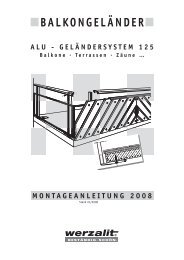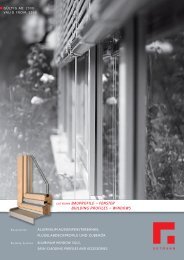gutmann bauprofile - fenster und türen building profiles ... - COM-MET
gutmann bauprofile - fenster und türen building profiles ... - COM-MET
gutmann bauprofile - fenster und türen building profiles ... - COM-MET
Sie wollen auch ein ePaper? Erhöhen Sie die Reichweite Ihrer Titel.
YUMPU macht aus Druck-PDFs automatisch weboptimierte ePaper, die Google liebt.
Ausschreibungstext<br />
Bidding documents<br />
Ausschreibungstext für Wetterschutzschienen für Holz<strong>fenster</strong><br />
Bidding documents for wood window weather bars<br />
Allgemein<br />
Die Konstruktion muss den Anforderungen der DIN 68121 Teil 2 „Holzprofile<br />
für Fenster <strong>und</strong> Fenster<strong>türen</strong>“ entsprechen. Die Entwässerung der<br />
Konstruktion wird durch Einsetzen einer Wetterschutzschiene im unteren<br />
Rahmenquerstück gewährleistet.<br />
Die Wetterschutzschiene ist geeignet zum Einsatz in Fenstern, die folgende<br />
Anforderungen erfüllen: Schlagregendichtheit nach DIN EN 12208, Klasse 9a,<br />
Fugendurchlässigkeit nach DIN EN 12207, Klasse 4 (entspricht DIN 18055,<br />
Beanspruchungsgruppe C für Gebäudehöhen bis 100 m). Durch eine Uw-<br />
Wert-Berechnung nach E DIN EN ISO 10077-2 muss nachgewiesen werden,<br />
dass die Oberflächen temperatur der Wetterschutzschiene am Anschlag der<br />
Flügeldichtung eine maximale Temperaturdifferenz von 2° C im Vergleich zum<br />
seitlichen Anschlag der Flügeldichtung (bei einer Außentemperatur von -10°<br />
C <strong>und</strong> einer Innentemperatur von +20° C) aufweist. Dies ist erforderlich,<br />
um die Kondensatbildung am Anschlag der Regenschiene weitestgehend zu<br />
verhindern.<br />
Das Aluminium-Profil ist aus EN AW 6060 T66 in Eloxalqualität nach DIN<br />
EN 12020, der Kunststoff-Teil aus PVC-freiem Material nach DIN 2768 Teil 1<br />
herzustellen.<br />
Konstruktionsaufbau der Wetterschutzschiene<br />
Zweiteilige Wetterschutzschiene in der Art, dass ein Aluminium-Profil in ein<br />
Kunststoffteil eingeklipst ist. Die Wetterschutzschiene muss konstruktiv ein<br />
Höchstmaß an thermischer Trennung realisieren: Das Aluminium-Teil darf<br />
daher als Wetterschutz nur im Außenbereich vor dem Flügel angeordnet<br />
werden. Im Bereich der Fälze ist nur wärmedämmender Kunststoff zugelassen.<br />
Der seitliche Abschluß der Wetterschutzschiene zum Rahmen wird mit<br />
einer Endkappe aus UV-beständigem Kunststoff ausgeführt. Die Andichtung<br />
der Endkappe muss durch nachträgliches Ausspritzen (nach Montage der<br />
Endkappe <strong>und</strong> Regenschiene) mit dauerelastischem Dichtstoff durch Spritzkanäle<br />
in der Endkappe erfolgen, um eine vollständige <strong>und</strong> kontrollierte<br />
Andichtung zu erreichen.<br />
Das Kunststoffteil umgreift einen Holzsockel, der am Blendrahmen unten<br />
einen Anschlag für die Flügeldichtung bildet <strong>und</strong> umlaufend mit den seitlichen<br />
<strong>und</strong> oberen Anschlägen eine umlaufende Dichtungsebene ohne Unterbrechungen<br />
bildet.<br />
Das Kunststoffteil der Wetterschutzschiene wird durch Einschlagen in einen<br />
Falz im Blendrahmen fixiert.<br />
Anzubietende Wetterschutzschiene:<br />
Gutmann Donau 22/24 F-Ti oder gleichwertig<br />
Angebotenes System:<br />
General<br />
Construction must conform to the requirements of DIN 68121 Part 2<br />
"Timber Profiles for Windows and French Doors". Drainage is achieved by<br />
placing a weather bar at the bottom of the transom.<br />
The weather bar is suitable for use in windows, which meet the following<br />
demands: Resistance to heavy rain in accordance with DIN EN 12208, class<br />
9a, joint permeability in accordance with DIN EN 12207, class 4 (equals<br />
DIN 18055, Load Group C for <strong>building</strong> heights up to 100 m). A heat transfer<br />
coefficient calculation in accordance with E DIN EN ISO 10077-2 must<br />
prove that the surface temperature difference of the weather bar at the sash<br />
gasket rebate and the side of the sash gasket rebate is no higher than 4 °F<br />
(assuming an outside temperature of 14 °F and an interior temperature of<br />
70 °F). This is necessary to prevent the accumulation of condensate at the<br />
weather bar rebate as much as possible.<br />
The aluminum profile must be manufactured from anodized EN AW 6060<br />
T66 in accordance with DIN EN 12020, while the plastic part must be manufactured<br />
from non-PVC material in accordance with DIN 2768 Part 1.<br />
Structure of the weather bar<br />
Two-part weather bars consist of an aluminum profile with a clipped on plas-<br />
tic part. The weather bar must create a highly effective thermal break: Therefore<br />
the aluminum may only be used for weatherproofing on the exterior of<br />
the sash. Only thermally insulating plastic is permitted aro<strong>und</strong> the rebates.<br />
The edges on the side of the weather bar up to the frame are covered with<br />
an end cover made of UV-resistant plastic. After installation of end covers<br />
and weather bars, the end covers must be filled with permanently elastic<br />
sealant (through spraying channels in the end cover) in order to achieve<br />
complete and controlled sealing.<br />
The plastic part encompasses a wood base, which forms a rebate for the<br />
sash gasket on the bottom of the frame and a continuous seal with the<br />
upper and lateral rebates.<br />
The plastic part of the weather bar is driven into a rebate in the frame to<br />
fasten it.<br />
Available weather bars:<br />
Gutmann Donau 22/24 F-Ti or equivalent<br />
Available system:<br />
71






